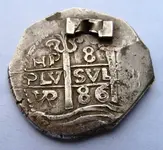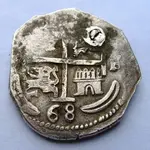Badger in NH
Tenderfoot
- #1
Thread Owner
I dug this Cob a couple weeks ago in a NH field. The farm dates from the 1690s. The fields around it have produced a few milled Spanish coins from the 1700s, as well as many Colonial coppers.
The coin weighs 23.8 grams and is a little larger than a Half Dollar. It seems to have two different dates. It also appears to have been clipped. There is another piece of silver on it, apparently for attaching the coin to something.
I'm hopping someone here can identify it and possibly estimate its value.
If it's fake I would like to know if it still might be Colonial.
The coin weighs 23.8 grams and is a little larger than a Half Dollar. It seems to have two different dates. It also appears to have been clipped. There is another piece of silver on it, apparently for attaching the coin to something.
I'm hopping someone here can identify it and possibly estimate its value.
If it's fake I would like to know if it still might be Colonial.





